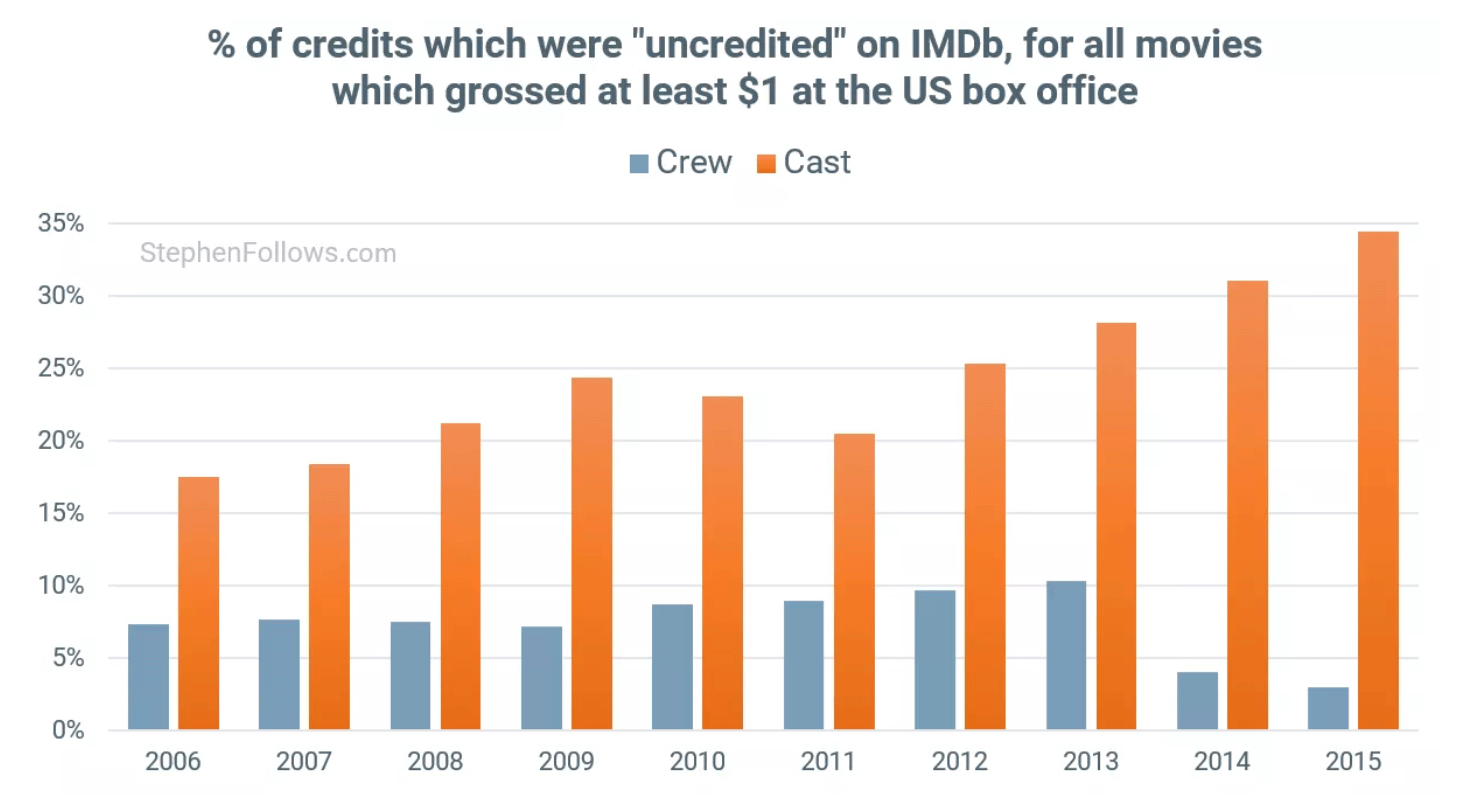How To Get The On-Screen Credit You Deserve
A lot of names get omitted from final end credits. Make sure yours isn't one of them.
This week we teamed up with producer and analyst Stephen Follows to look at an interesting question: who gets included, and excluded, in the final end credits of a movie?
Stephen started by analyzing the number of IMDb entries tagged as “uncredited”. Right away, the numbers jumped out at us:
When I reached out to colleagues about this topic, there was no shortage of horror stories: from news companies that refuse to credit any assistant editors, to TV shows and Oscar nominees that had cut their colorists out altogether. (Guys: respect your colorists.) Below, we unpack this issue and explain how to avoid becoming another “uncredited” statistic.
And if you don’t know Stephen Follows—think of him as the Nate Silver of the film industry. We strongly encourage you to check out his site, and his “Uncredited Credits” article that is a companion piece to this one.
1. End credits have become more inclusive—and a lot longer.
We’ve come a long way from “The Wizard of Oz” (1939), whose end titles featured a whopping eleven names, one of them a dog. It’s not just blockbuster movies, either: ask us some time about the one that thanked all 10,003 donors by name.
Perhaps the clearest illustration lies in font sizes. Fewer names mean more space to accommodate larger type. With more names, point sizes have to shrink.
Witness the giant, horsey text of 1980s and 90s actions movies alongside their contemporary peers. Here’s a snapshot of three decades:

Left to right: “FACE/OFF” (1997), “300” (2006), and “Deadpool” (2016). Images are to scale. Click to enlarge.
2. But very few on-screen credits are actually guaranteed.
Some unions and guilds have explicit rules governing on-screen credits. These generally affect above-the-line and key crew positions. The DGA, for example, spells out specific requirements around the Unit Production Manager, as well as First and Second Assistant Director positions.
But these are the exception. Below the line, virtually everything is a courtesy—common practice, but a courtesy nonetheless. Digital Imaging Technicians (DITs) report that “Every start work packet makes it very clear that on-screen credit is at the producer’s discretion”. Considering that the DIT is a fairly critical on-set role, most other crew positions can hardly expect to fare better.
3. Post production has a visibility problem.
Why should a Production Office PA receive a credit, but not a Post Production PA?
Post production is often invisible: the Office PA is employed directly by production, gets listed on call sheets, and has personally interacted with producers. The Post PA on the other hand is employed by a third-party vendor, doesn’t show up on call sheets, and is therefore easier to overlook.
Bias against post production crops up in other areas. One media services company we spoke with offered both production and post production gear rental. The manager in charge of the former was credited 100% of the time; the manager in charge of the latter (Unity, AVIDs, decks) was only credited about 50% of the time.
4. “There is no room” is a poor excuse.
A common excuse for withholding credit is that there is just “not enough room.”
So we decided to run some numbers against that claim.
Quick background: Endcrawl has thousands of active projects, and nearly a thousand completed feature film projects. We can confidently state that our service has created more end credits sequences than any other single company has over that past several years. And there are no more than a handful of companies that have made more than we have, in total, during their entire existence.
So our data set is pretty solid.
That in mind:
- The average Endcrawl feature film project contains 381 credits (persons and entities).
- The average end credits render runs 3 minutes and 47 seconds.
- Analyzing the pixel heights and aspect ratios of all projects, we determined that there is an average of 18.23 names on screen at any given time.
18 is low number. Looking back at the above side-by-side examples: FACE/OFF is displaying 13 names, 300 shows 22, and Deadpool packs 34 names on the same surface area. Apart from bumping down font size, there are many other ways to maximize your canvas. Here’s a simple tightening exercise:
The real estate is there, if you want to use it.
5. People are often forgotten, not jilted.
If you’ve ever been left out of the credits, more likely than not someone simply forgot.
There are ways around this. Too often end titles sequences are built in last-moment, dog-ate-my-homework cram sessions. So some of our customers have started building their end credits during pre-production. This saves a world of hurt later on.
(And since Endcrawl charges flat rates per project, you’re free to build your end credits over the course of months or even years, if you like.)
Vendors can be more pro-active as well. When I was running a post production boutique, I always, always, submitted a full list of names to my clients—down to the last post PA, intern, and third-shift digital lab assistant.
We didn’t always get “yes” for an answer. But we always tried.
6. Ask and you shall receive.
So how can you make sure you don’t get left out? In a word: ask.
Talk to your department key.
In many cases, the department keys are responsible for submitting final crew lists for credits. If you’re concerned that you might have been overlooked, start here. Any key worth their salt will want their entire crew to be properly acknowledged.
Talk to your employer.
If you work for a post house, the same principle applies. We conducted an extremely non-scientific poll, and found that it is not common practice to submit comprehensive post credits to clients. That should change. If you’re a post production worker: speak to your employer about this. Tell them I sent you.
Talk to the post super.
If you still feel that you’ve been forgotten, consider reaching out to the post post production supervisor directly. They are commonly the last gatekeeper of the credits. Some caveats: keep it courteous and short. Contact them once, and once only. Post supers are some of the hardest-working souls in the business. Between the renders and the politics, they already have enough on their plate.
Talk to IMDb.
If you’ve hit a wall everywhere else, you can still submit directly to IMDb. When I ran a post house, we tasked some of our employees with regularly updating everyone’s IMDb list. It was a small, but meaningful, way to show our employees respect and gratitude.
But if nothing else, you have to grab these reins yourself. Your IMDb page is not the last word on your career. But it is an important public record. Own it.
Bottom line: producers can credit you if they want to; and you can be more pro-active about controlling your c.v.
We’d love to hear about your experiences, good or bad, in the comments.
Finally: don’t forget to read Stephen Follows’ deeper dive into these numbers.
Hey, while you're here ...
We wanted you to know that The End Run is published by Endcrawl.com.
Endcrawl is that thing everybody uses to make their end credits. Productions like Moonlight, Hereditary, Tiger King, Hamilton—and 1,000s of others.
If you're a filmmaker with a funded project, you can request a demo project right here.
The Difference Between a Font and a Typeface
A lot of names get omitted from final end credits. Make sure yours isn't one of them.


